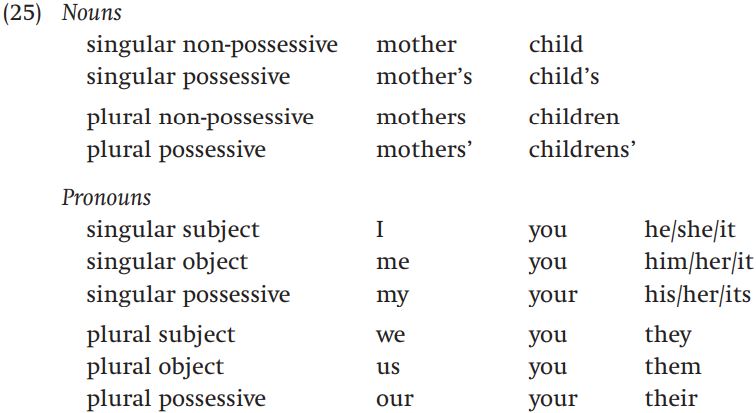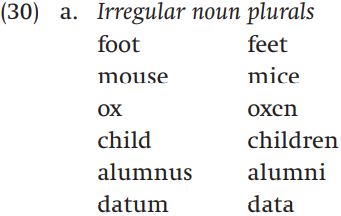

Grammar


Tenses


Present

Present Simple

Present Continuous

Present Perfect

Present Perfect Continuous


Past

Past Simple

Past Continuous

Past Perfect

Past Perfect Continuous


Future

Future Simple

Future Continuous

Future Perfect

Future Perfect Continuous


Parts Of Speech


Nouns

Countable and uncountable nouns

Verbal nouns

Singular and Plural nouns

Proper nouns

Nouns gender

Nouns definition

Concrete nouns

Abstract nouns

Common nouns

Collective nouns

Definition Of Nouns

Animate and Inanimate nouns

Nouns


Verbs

Stative and dynamic verbs

Finite and nonfinite verbs

To be verbs

Transitive and intransitive verbs

Auxiliary verbs

Modal verbs

Regular and irregular verbs

Action verbs

Verbs


Adverbs

Relative adverbs

Interrogative adverbs

Adverbs of time

Adverbs of place

Adverbs of reason

Adverbs of quantity

Adverbs of manner

Adverbs of frequency

Adverbs of affirmation

Adverbs


Adjectives

Quantitative adjective

Proper adjective

Possessive adjective

Numeral adjective

Interrogative adjective

Distributive adjective

Descriptive adjective

Demonstrative adjective


Pronouns

Subject pronoun

Relative pronoun

Reflexive pronoun

Reciprocal pronoun

Possessive pronoun

Personal pronoun

Interrogative pronoun

Indefinite pronoun

Emphatic pronoun

Distributive pronoun

Demonstrative pronoun

Pronouns


Pre Position


Preposition by function

Time preposition

Reason preposition

Possession preposition

Place preposition

Phrases preposition

Origin preposition

Measure preposition

Direction preposition

Contrast preposition

Agent preposition


Preposition by construction

Simple preposition

Phrase preposition

Double preposition

Compound preposition

prepositions


Conjunctions

Subordinating conjunction

Correlative conjunction

Coordinating conjunction

Conjunctive adverbs

conjunctions


Interjections

Express calling interjection

Phrases

Sentences


Grammar Rules

Passive and Active

Preference

Requests and offers

wishes

Be used to

Some and any

Could have done

Describing people

Giving advices

Possession

Comparative and superlative

Giving Reason

Making Suggestions

Apologizing

Forming questions

Since and for

Directions

Obligation

Adverbials

invitation

Articles

Imaginary condition

Zero conditional

First conditional

Second conditional

Third conditional

Reported speech

Demonstratives

Determiners


Linguistics

Phonetics

Phonology

Linguistics fields

Syntax

Morphology

Semantics

pragmatics

History

Writing

Grammar

Phonetics and Phonology

Semiotics


Reading Comprehension

Elementary

Intermediate

Advanced


Teaching Methods

Teaching Strategies

Assessment
Inflection in English
المؤلف:
Rochelle Lieber
المصدر:
Introducing Morphology
الجزء والصفحة:
99-6
21-1-2022
2546
Inflection in English
What we have
As we’ve seen in passing in the sections above, English is a language that is quite poor in inflection. The distinction between singular and plural is marked on nouns:

English has only a tiny bit of case marking on nouns: it uses the morpheme -s (orthographically -’s in the singular, -s’ in the plural) to signal possession, the remnant of the genitive case. Pronouns, however, still exhibit some case distinctions that are no longer marked in nouns:

In verbs, number is only marked in the third person present tense, where -s signals a singular subject. As we’ve seen, English verbs inflect for past tense, but not for future, and there are two participles (present with –ing and past with -ed) that together with auxiliary verbs help to signal various aspectual distinctions:

Distinctions in aspect and voice are expressed in English through a combination of auxiliary choice and choice of participle. The progressive, which expresses, among other things, on-going actions, is formed with the auxiliary be plus the present participle:

The perfect (note that the perfect is not the same as the perfective, which we discussed above) expresses something that happened in the past but still has relevance to the present. This is signaled in English with the past participle and a form of the auxiliary have:

The passive voice in English is formed with the past participle as well, but the auxiliary be is used instead of have:

It is, of course, possible to combine various auxiliaries and participial forms to express tense/aspect distinctions that are quite complex, as in, for example, the past perfect progressive passive sentence I had been being followed by a voracious weasel.
As you can see in (25)–(29), English has both regular and irregular inflections. All of our regular inflections are suffixal, but irregular forms are often formed by internal stem change (ablaut and umlaut) or by a combination of internal stem change and suffixation. Examples of irregular forms are given in (30):


We could no doubt think of more examples as well. It is often said that the irregular plurals and past tenses in English form closed classes; that is, they constitute a fixed list from which particular forms can be lost, but to which no new forms can be added. The regular plural and past tense endings are considered default endings. In other words, when a new noun is added to English, its plural is formed with -s and when a new verb is added, its past tense is formed with -ed. So if we borrow a noun from another language or coin a completely new noun, their plurals will be formed with the regular suffix (fajitas, wugs). Similarly for new verbs (googled).
Why do we have irregular forms? In some cases, they are the remnants of ways of forming the plural or past tense that we no longer have today. We saw in chapter 5 that plurals like foot ~ feet and mouse ~ mice are the remnants of a rule of umlaut that was lost at the earliest stages of English. The irregular verbs are also a remnant of a way of inflecting verbs that goes all the way back to the Germanic ancestor of English and even beyond that to the way of inflecting verbs in proto-Indo-European. The details of how that kind of inflection worked need not concern us here, except to say that it involved internal vowel changes (ablaut). Suffice it to say that that form of inflection is no longer used to inflect new verbs in English.
 الاكثر قراءة في Morphology
الاكثر قراءة في Morphology
 اخر الاخبار
اخر الاخبار
اخبار العتبة العباسية المقدسة

الآخبار الصحية















 قسم الشؤون الفكرية يصدر كتاباً يوثق تاريخ السدانة في العتبة العباسية المقدسة
قسم الشؤون الفكرية يصدر كتاباً يوثق تاريخ السدانة في العتبة العباسية المقدسة "المهمة".. إصدار قصصي يوثّق القصص الفائزة في مسابقة فتوى الدفاع المقدسة للقصة القصيرة
"المهمة".. إصدار قصصي يوثّق القصص الفائزة في مسابقة فتوى الدفاع المقدسة للقصة القصيرة (نوافذ).. إصدار أدبي يوثق القصص الفائزة في مسابقة الإمام العسكري (عليه السلام)
(نوافذ).. إصدار أدبي يوثق القصص الفائزة في مسابقة الإمام العسكري (عليه السلام)


















